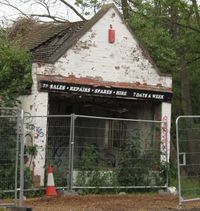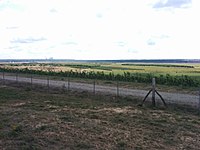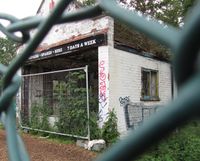Key:abandoned:*
| Description |
|---|
| Namespace for features that have been abandoned by their owner, but which are still useful for navigation and visible in the landscape. Immediate reuse is not planned, and they may have fallen into disrepair. |
| Group: lifecycle |
| Used on these elements |
| See also |
| Status: in use |
| taginfo: abandoned:* |
Description
The abandoned:*=* lifecycle prefix can be added to tags that relate to features that have fallen into serious disrepair and which could only be put back into operation with expensive effort. Such features will still have some physical form reflective of their former use visible in the landscape.
For features which might be returned to use without significant repair efforts, see the key prefix disused:*=* instead. Use of abandoned=* as a simple tag is discouraged in some situations (for example abandoned=yes + shop=*).
How to tag
Add the lifecycle prefix abandoned:*=* to all keys which are no longer relevant to the current state of an object. You should treat all the tags on an object as a set of facts about the object, and prefix the keys of those facts which are no longer true as a result of the abandonment. For example, an abandoned shop which still carries a name sign might be tagged as
- abandoned:shop=doityourself
- name=Holby Tool Supplies
which makes it unavailable to programs which locate shops, and unlikely to be displayed as a shop in any default renderings. The name is still relevant, and will still be searchable. If the shop is repaired and reopened, it's a simple matter to undo the prefixing.
Examples
| Image | Tags | Description |
|---|---|---|

|
abandoned:shop=bicycle building=yes old_name=The Little Example Bike Repair Shop |
Derelict bike repair shop that can't be brought back into use easily. It's still a building, however: most of the roof's still on, and the walls are standing. The tagging reflects its former use, and the fact it's still a building. |

|
abandoned:highway=unclassified abandoned:ref=A6187 highway=path name=Example Street |
Subsided former turnpike road in Derbyshire, UK, abandoned in the 1970s as a result of a landslide. Still somewhat passable on foot and by bicycle, so it gains a (new, different) highway=* tag, and loses its former reference number. |

|
railway=abandoned name=The old name |
abandoned rails; track has been removed and the line may have been reused or left to decay. Note that railway tagging is typically using a separate tagging scheme for abandoned and disused infrastructure. |

|
landuse=quarry + abandoned=yes | Abandoned quarry. Note that lifecycle scheme is not used here - that is because quarry describes landscape feature, not company operating there. This is a case where abandoned=yes is still recommended. |

|
abandoned:landuse=quarry | The open pit of a lignite mine was recultivated here. There is again land covered with shrubs, bushes or wood. Note that due to verifiability, remnants of the quarry should still be visible for it to be mapped. |
Use as a simple tag
Using abandoned=yes as a simple tag is now discouraged in many cases, but there are many uses of it in the database. It was used for the same purpose as described above, but the syntax was unhelpful because automated consumers of the data would have had to be rewritten. This, in practice, has not happened.
- A simple feature such as a building that fell into decay might be tagged with building=yes + abandoned=yes. This is fine.
- But for more complex features with multiple tags it is sometimes unclear which tags were still relevant, and which were not. For example, consider an object tagged with railway=rail + abandoned=yes + highway=track + surface=paved. Does the abandoned=yes tag refer here to the railway, the highway, or both? Does it also refer to the surface tag? Note that this case could be avoided by splitting object in two ways or by using railway=abandoned/railway=disused as usual.
- It's also problematic that automated data consumers which don't know about the abandoned=yes tag would need to be rewritten (and it's not at all clear about what to do).
- Therefore, you must also make any tags which no longer have current meaning as a result of the abandonment unavailable to software which doesn't know about the abandoned=yes tag. This can be done by prefixing their keys with the namespace abandoned:*=* — see the examples.
Updating older tagging
Uses of the simple tag where it is misleading (objects such as shops, amenities) should ideally be updated as follows:
| Older scheme (deprecated) | Intermediate scheme (discouraged) | Current scheme (recommended) |
|---|---|---|
| shop=bicycle building=yes name=The Little Example Bike Repair Shop abandoned=yes |
abandoned:shop=bicycle building=yes name=The Little Example Bike Repair Shop abandoned=yes |
abandoned:shop=bicycle building=yes old_name=The Little Example Bike Repair Shop |
| abandoned=yes ref=A6187 highway=unclassified name=Example Street |
abandoned=yes abandoned:highway=unclassified abandoned:ref=A6187 highway=path name=Example Street |
abandoned:highway=unclassified abandoned:ref=A6187 old_name=Example Street |
- The name and building-nature of the first example are still relevant, so those keys don't get namespaced.
- For the road, the newer schemes allow a new use as a path to be expressed.
- It's now suggested to remove the abandoned=yes too.
Possible Tagging Mistakes
See also
- abandoned=* - A man-made feature abandoned and no longer maintained
- shop=vacant - Shop that is currently not being used
- disused:*=* - Namespace for features that have fallen into disuse, but which are still useful for navigation and visible in the landscape
- Lifecycle prefix
- Comparison of life cycle concepts
- Open Historical Map
